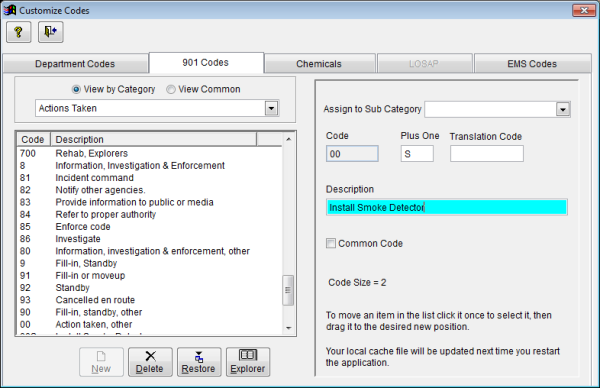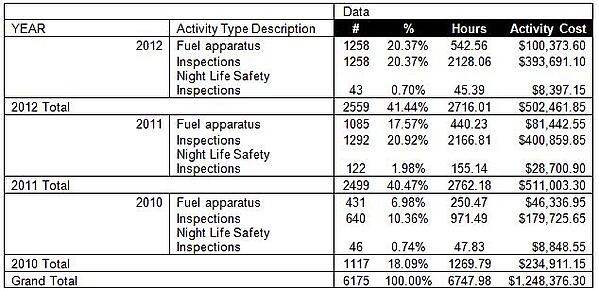Fire Departments Can Win More Grant Funding: Here’s How
What Does Your NFIRS Data Tell You?
Some might say "I don’t use the data, I only report it to the Feds so that I can get grant money"; others might say "it tells me how well I am doing in my response times" or "it tells me my fire loss for the year"
Was this information valuable?

Some might say "I don’t use the data, I only report it to the Feds so that I can get grant money"; others might say "it tells me how well I am doing in my response times" or "it tells me my fire loss for the year". With almost 700 data elements in the National Fire Incident Reporting System (NFIRS) specification, this does not include any custom tabs created and their related look codes in FireRMS, there is a wealth of data trapped in the box. Below are just a few examples of how this wealth of data can be used.
1. Trap & Calculate Customer Service Issues
The ability to create “plus one codes” allows us to trap and calculate customer service issues like just how many smoke detectors did you install last year? With 0 to 9 and 26 letters in the alphabet you can come up with some inventive ways to track this and many other items. Using a plus one code will allow you to trap the action taken on any call at either the incident level or the apparatus level. Where you put it is up to you. Just make sure to enter the data in a standardized manner within your department so that you can then track it. SeaTac Airport, south of Seattle, WA tracks many things such as time spent on various tasks related to calls by using plus one codes (Rogers, 2013).

Figure 1: FireRMS Customizing 901 Codes
2. Track Time Spent on Tasks
Ever wonder just how much time you spend getting fuel? The daily log can be invaluable when trying to trap how much time we spend doing certain tasks. In this day and age we need to prove why we need money, and the only way to do this is to use facts, i.e. data. My agency is currently moving to the occupancy module. In order to “sell the idea”, I used a pivot table to create some aggregate statistics on inspection data, and found a staggering amount of money being spent on inspections. I found by using the data contained in FireRMS that my agency had spent over 1.2 million dollars on inspections and fuel runs in the last three years. One possible use of this data would be helping to justify adding an inspector or two to the organization and have them conduct the inspections in a much more fuel efficient vehicle than a ladder truck or engine driving all over town doing inspections. Please do not misunderstand me, I am not advocating that response companies should not do Company Inspections, I am merely pointing out that we can find ways to provide better customer service and do follow-up inspections (Tukwila Fire Department, 2013).

Figure 2: Tukwila Fire Dept. Inspection Data
3. Help Determine Dollar Loss & Economic Impact
Speaking of customer service, do you need to know how effective your sprinkler ordinance is? Try looking at the number of heads activated during your fires and then look at the amount of money/property saved correlated to the number of fires in buildings with and without sprinkler
systems. What is the impact of the fire in the building without a suppression system?
A recent article in Fire Engineering, “The Economic Impact of Firefighting: A New Way to View Firefighter Service” (Kreis, 2013), suggests that we need to start thinking of what we save in terms of dollars and jobs, not just the dollars lost due to property damage and content loss. The economic impact of a fire can be minor or it can equate to a national security issue. For example, a 5x5 brush fire is really nothing compared to when a worker starts a fire in a nuclear submarine (Firefighters Injured Fighting Fire Aboard Nuclear Submarine, 2012), (Navy Drops Plans to Repair Fire-Damaged Submarine, 2013). Both fires do have an impact on the agency’s budget i.e. how long the unit was out of service, fuel costs, foam used, fire service / civilian injuries, concurrent calls handled by other units, not to mention tax revenues lost. The list goes on and on.
4. Inform your Strategy & Tactics
FireRMS has a wealth of data. Depending on your specific needs, you can get at all kinds of data that is buried in the box. For example, filling out the pre-incident value of the property can give you the dollar loss and the dollars saved values, while looking at the occupancy module you can tell just how many “unsecured and vacant” structures you have in your jurisdiction. If you could tell just how many of those structures have a bow-string truss roof would that help you plan your strategy and tactics?
What does your FireRMS data tell you? Mine tells me call distribution, mutual aid usage, dollar loss, time spent on tasks… All I have to do is get the data into FireRMS, but that is a whole other post!
Works Cited
Firefighters Injured Fighting Fire Aboard Nuclear Submarine. (2012, May 24th). Retrieved September 27th, 2013, from Fire Engineering: http://www.fireengineering.com/articles/2012/05/firefighters-injured-in-fire-aboard-nuclear-submarine.html
National Fire Incident Reporting System. (2013, September 27th). Retrieved September 27th, 2013, from 2013 Cycle Changes: https://www.nfirs.fema.gov/documentation/design/
Navy Drops Plans to Repair Fire-Damaged Submarine. (2013, August 7th). Retrieved September 27th, 2013, from Fire Engineering: http://www.fireengineering.com/articles/2013/08/navy-drops-plans-to-repair-fire-damaged-submarine.html
Kreis, T. (2013, August 6th). The Economic Impact of Firefightring: A New Way to view Firefigher Service. Retrieved September 27th, 2013, from Fire Engineering: http://www.fireengineering.com/articles/print/volume-166/issue-8/features/the-economic-impact-of-firefighting-a-new-way-to-view-firefighter-service.html
Rogers, T. (2013, August). NFIRS Program Manager. (J. R. Schell, Interviewer)
Tukwila Fire Department. (2013). NFIRS Data. Tukwila, WA, USA.
Related Posts
5 Things Fire Departments Need To Know About the NFIRS to NERIS Transition
How Fire and Battalion Chiefs Can Get the Data They Need for Funding, Staffing, and Safety
ZOLL Pulse Blog
Subscribe to our blog and receive quality content that makes your job as an EMS, fire, hospital, or AR professional easier.
ZOLL Pulse Blog
Subscribe to our blog and receive quality content that makes your job as an EMS, fire, hospital, or AR professional easier.




